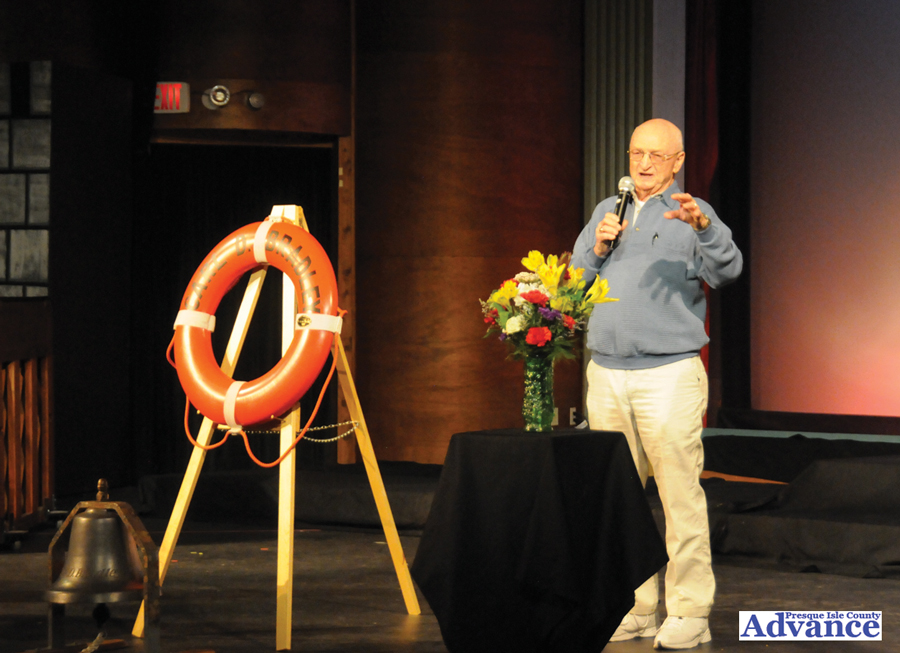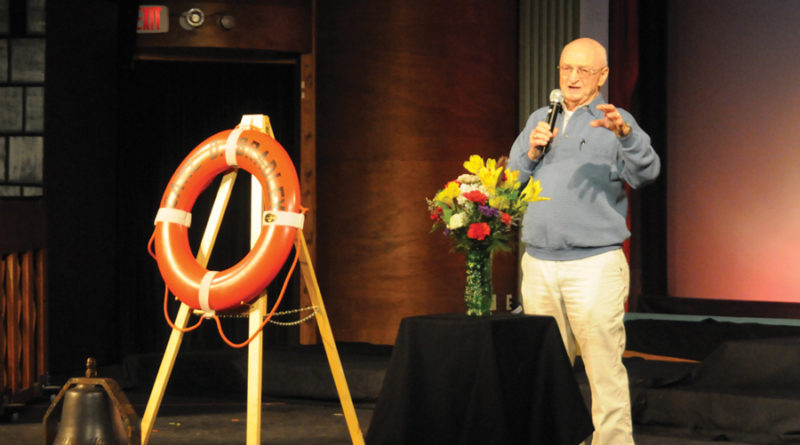Crew of Bradley remembered at 60th anniversary
by Richard Lamb–Advance Editor
Tears flowed and emotions were high at the 60th anniversary bell-ringing ceremony in remembrance of the Carl. D. Bradley. The Bradley broke in half in a Lake Michigan storm, the evening of Nov. 18, 1958, claiming the lives of 33 crew members.
The event, sponsored by the Great Lakes Maritime Lore Museum and the Presque Isle District Library, packed every seat in the Rogers City Theater, with many standing in the rear of the theater. Lore museum board president Dave Erickson welcomed the audience and after presentation of the colors and a prayer from the Rev. J. Derek Riddle pastor of Peace Lutheran Church, the St. Ignatius Catholic School children’s choir, directed by principal Amy Rabeau, presented a song, “The Journey.”
Rogers City mayor Scott McLennan, diver John Janzen and Bradley survivor Frank Mays were featured speakers at the event.
Mays, who signed copies of his book “If We Make It Until Daylight,” recalled the events of the chilling night. He started his 13-minute talk by saying the ship unloaded what crew members thought would be the final load of the season in Gary, Indiana.

“We started calculating when we would arrive at our next port,” Mays said recalling that the ship would head to Manitowoc, Wisconsin to have a new cargo hold installed.
“The old one was really in bad shape and we were loosing rivets and the ballast tanks were leaking into the tunnel. We anticipated that we should be in Manitowoc by 2 or 2:30 in the afternoon of Nov. 18,” Mays said.
He planned to be back home in Rogers City in time for Thanksgiving. But plans for the ship changed, he said. When he got up early in the morning for his watch shift at 3:30 a.m., he saw the lights from the Wisconsin shoreline. He finished his shift, went to bed around 8 a.m. and woke up for his afternoon shift as deck watch. By then the orders had changed and the Bradley set course for Rogers City.
“The seas were pretty rough. We were bouncing around, but it didn’t bother me,” Mays said. First mate Elmer Fleming instructed Mays to go back to the coal bunker and make sure it was pinned and clamped because of anticipated rough water ahead.
He then went into the engine room and the stoker man’s room and dogged the doors down.
“Then I’m strolling down the tunnel and you can see the ship bend and twist and you would hear a ping, so you knew she was snapping rivets,” Mays said. He arrived upstairs and talked with deckhand Gary Price, who had instruction from Fleming to wait there.
“As we were talking all of a sudden there was a big slam and the ship started to shake. That was followed by another one. We looked at each other and thought did we hit something or did something hit us. We raced up on deck and looked on the port side. The stern section wasn’t there. Then we looked up and it was there. It was like it was on a hinge,” Mays recalled.
He ran to his room and grabbed a lifejacket and went for the life raft on top of the pilothouse. Since he was on watch, Mays was dressed for the weather, as were Price and Fleming, but many were not, since they were sleeping or working inside the ship.
The order to abandon ship came as the ship began to “tear apart like a piece of paper,” Mays said. He climbed aboard the life raft and moments later found himself in the water.
“When I got to the surface, I don’t know how deep I went, I went like I was going to swim but my arm hit the life raft,” Mays said. He helped Fleming aboard and then helped Gary Strzelecki and Dennis Meredith climb aboard the raft.
At this time the bow section was gone but they saw the stern section floating before it tipped and went underwater in a fireball.
Surviving on the raft proved to be very difficult, to say the least. Mays tried to describe how he felt on the raft, cold, riding the big waves in the dark on a chilling November night.
“Go down to Lake Huron and submerse yourself. Then come out. Go lay down on the beach for a while and start to shiver and shake. Go back again and go back three times. On that life raft we rode those waves and three times we were back in the water. Now think of that,” Mays said.
That went on for 15 hours. On the raft he said if they make it to daylight, they would be found. Two survived the night, Mays and Fleming, and they were found the next day.
Professional diver John Janzen showed underwater video of the ship taken over several years. Janzen led a team to recover the ship’s bell and later replaced it with a tribute bell with the names of the crew engraved.
“I never expected that diving on any shipwreck could change my life so much, but that’s what the Bradley did for me,” Janzen said. Reaching the depth of 375 feet was way beyond recreational divers at the time.
“For six years we trained for this and put unbelievable amounts of money into buying equipment. Some of it wasn’t even available so we made it ourselves. Practically everyone we talked to about this was convinced that we couldn’t do it and were crazy to try, and I was starting to believe them,” Janzen said.
That came before the divers heard Frank Mays speak in 2004 about surviving the sinking. They met Mays at the event and asked for Mays’ blessing.
“His response blew me away. Frank said ‘if you go to the bow, there is this jar of coins that I used for poker bets. Could you please go get that back for me?’” Janzen said and the project picked up steam.
He thanked Mays for showing them the confidence to make the dive.
“The men lost Nov. 18, 1958 are not forgotten, just look around here. I can tell you from my own experience, in a way I cannot explain or understand, they reached out to me when I was on the Bradley and I felt it,” Janzen said.
He showed what he called the most comprehensive video about the Bradley ever shown, narrating as the audience watched the big screen.
McLennan welcomed the audience, reminding the crowd that 23 of the men lost were from Rogers City.
“Today, here right now, we as friends, sons, daughters, grandchildren, fellow sailors and others come together in this small-town theater to remember that day Nov. 18, 1958 when 33 good men were lost. Men that are missed to this day,” McLennan said.
Following the presentations, the names of the crew were read by museum board member Roger Hulett as friends and family members rang the ship’s bell.
The afternoon’s ceremonies ended with the presentation of the Emmy award-winning film “November Requiem” produced by the sister and brother team of Ann and Brian Belanger. The film, first presented at the theater 10 years ago, served as a fitting conclusion to the solemn day.

